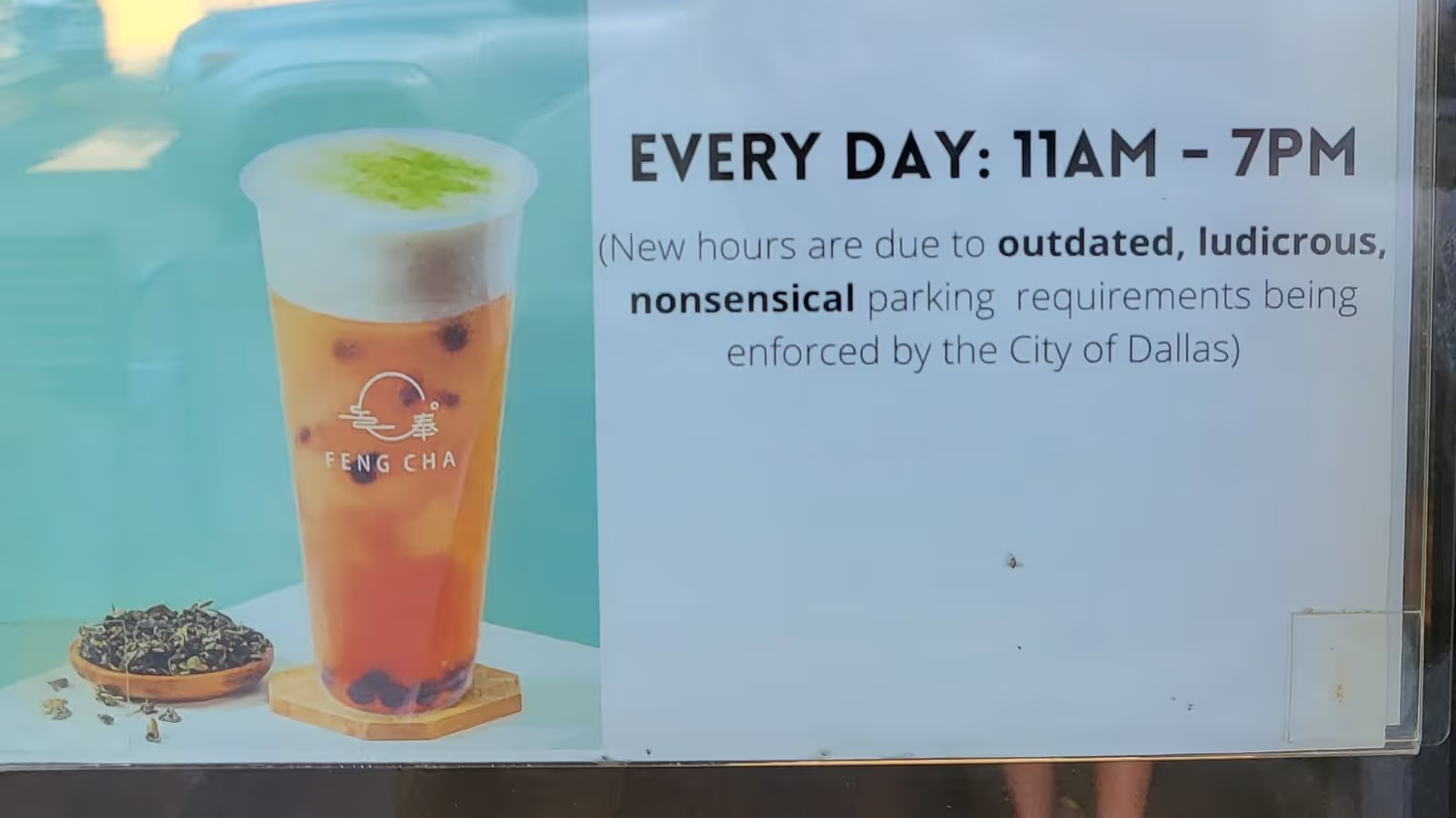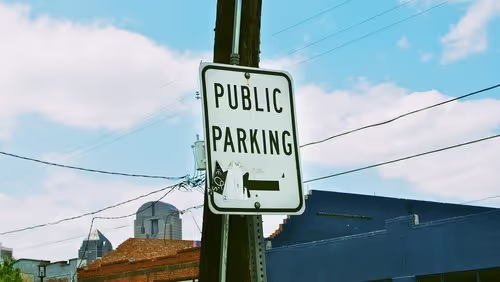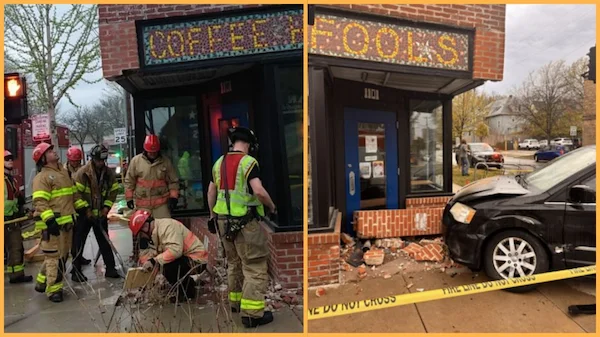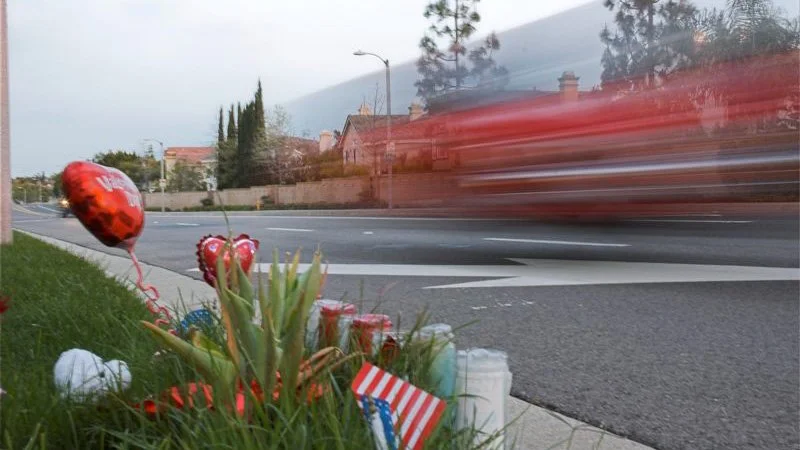Editor's Note: The challenges our cities face are growing, but so is the strength of this movement. Every story we share, every idea we spread, and every tool we build exists because people like you are committed to showing up. Your membership isn’t passive—it’s the momentum that makes change possible.
“The vast majority of people in Dallas have no idea Dallas used to be walkable,” says Hexel Colorado, a Dallas native who, among many endeavors, runs the Dallas Urbanists Instagram account. “The idea that Dallas was built for the car and that we’ve always had parking lots is a myth.”
Colorado has returned time and time again to a video showcasing what may have been an average day in Dallas in 1939. In it, Main Street is bustling with people and the density of theaters, restaurants, offices, and homes, unrecognizable to today’s Dallasites, who better know that same stretch for its parking lots.
A few years later, much of the structures in that video would be leveled for a combination of city hall, expressways, and parking lots. For the next 60 years, Dallas, like countless cities across the country, would continue to increase the footprint of both its expressways and its parking lots. As it did, distances between where people lived, worked, studied, and played would grow and grow until it became decidedly inconvenient, if not impossible, to get around without a car.
In this same period, a method of transportation designed to move people longer distances, the streetcar, was in its final death throes. At its height, the streetcar system boasted nearly 400 streetcars and 200 miles of track, operating from Downtown to Uptown, Oak Cliff to Oak Lawn, and beyond. But by 1930, the allure of the automobile was signaling the end of the streetcar and they began phasing out until the mid-1950s, when most streetcars would run for the last time. The mayor who oversaw the end of the system even reportedly said, “Dallas will never be a modern city as long as it is tied to an antiquated, electric rail system.”
Dallas’ core began to empty, entire neighborhoods were razed for parking lots, suburban divisions on the fringes of what were once considered city limits multiplied, public transit nearly disappeared, and within a few years, the Dallas depicted in that 1939 video barely had anything in common with the Dallas of the 1960s and onward. Now, it’s the poster child for traffic-choked expressways and an asphalt-rich downtown.
It Doesn’t Have To Be This Way
However, there’s a growing number of Dallasites, like Colorado, who are trying to change course. If they look to the past, it’s not to romanticize it, but to showcase that what exists today was not always the case and, in fact, the shift was swift, destructive, and broadly unwanted. They also use history to illustrate the irony of what is illegal to build in Dallas today. That’s why everyone from council members to advocates are championing parking reform in the Texas city.
“I’m over it,” Dallas City Councilmember Chad West said of parking mandates. West has been advocating for parking reform since at least 2017, when the construction of a hotel was rendered impossible by the city’s mandates. “It was a ridiculous overparking requirement for a hotel,” he told the Observer. The law stipulated one parking space per room, in this case 12 total, and 25 spaces for the restaurant. “But the crazier part of it all was that this occurred within one block of the streetcar stop and within like four blocks of the Bishop Arts District where people are taking Ubers and Lyfts, and walking,” West added. “So, it made no sense for this parking requirement to be in existence.”
In 2019, he authored a memo to the city manager asking them to examine the mandates and, ultimately, plan to reduce if not eliminate them. The memo first fell on skeptical ears and later, to the bottom of a growing list of priorities as the pandemic seized Dallas in 2020. In 2023, West filed another memo, cosigned by five council members. This memo evolved into a proposal shaped by the city’s planners, and now it’s going through several stages until it reaches all 14 members of city council, who will have the final say.
Just a few weeks ago, it passed the first stage: a Zoning Ordinance Advisory Committee, or ZOAC, meeting. Colorado actually provided public comment in support of reforms at that hearing. His plan was to debunk the notion that eliminating parking minimums would leave businesses “struggling to survive.” It was, in essence, a response to how a council member opposed to reform framed an article they shared on Twitter/X.
When Colorado read that same article, he failed to see what the council member was claiming. In fact, he saw the opposite: “foot traffic and patronage increased by all accounts in that sector. If not for the article’s misleading headline, you wouldn’t have guessed that parking minimums had an adverse impact on businesses.”
That article did truthfully highlight one or two struggling businesses. Given their proximity to the others who could not assert they were worse off, deducing that parking contributed to their struggles felt unfair, Colorado noted. “No business, generally, will concede that their service, inventory, or hours is why they’re not doing well,” he added. “Of course, external factors can impact business, but given the trend in this area, parking didn’t seem to be that factor.”
Yet, as he listened through arguments for and against eliminating parking mandates, he realized he could contribute something much more meaningful to the conversation. “So many people opened up with, ‘We’re not New York,’ ‘We’re not Amsterdam,’ ‘We’re not Chicago.’ Everybody has this idea locked in about what Dallas is today and this myth that the way Dallas is today is the way it's always been and therefore, it is impossible for Dallas to be anything else.” he explained. “And so, if I can just convey that Dallas used to be something else not that long and go, and in fact, there are people alive who remember it, I can ask: we’ve changed before, why not change again?”
So, throughout the hearing, Colorado began chopping up that 1939 video, first aired in 2014 on the Dallas Morning News thanks to the efforts of “Dallas’ OG urbanist,” as Colorado put it, Patrick Kennedy. He knew that if he could package it for social media, he could reach a much wider audience and specifically, more Dallasites, whom he felt needed to know that historic Dallas was more like Chicago, New York, and even Amsterdam than anyone in this hearing was willing to admit. Not to mention, the city’s parking mandates only came about in the 1960s. Why should the whim of a handful of men 60 years ago continue to shape today’s Dallas?
Don’t We Need To Guarantee Parking?
For Tony Jordan of the Parking Reform Network, it’s not just that parking mandates are antiquated, they’re arbitrary. He points out how Dallas has drawn a distinction between a “dry cleaner” and a “laundry service” through its code, mandating that the former provide 30% more parking than the latter. “These are effectively the same land use, so it just doesn’t make sense,” he says, adding that a laundry service is already required to provide one spot for every 300 square feet of space. With a single parking spot averaging around 350 square feet, this means that, at minimum, surface parking is required to be larger than the establishment, itself.
The calculus can get quite awkward. A church, for example, must accommodate a parking stall for every 333 square feet if the overall space is under 5,000 square feet. Otherwise, the minimum amount of parking mandated by law is determined by how many parishioners fit in a pew. In the absence of pews, another formula is offered. Calculating parking minimums for schools, shelters, hotels, and banks involves similarly unwieldy ratios.
Even hours of operation influence how the city calculates parking. The City Planning Commission denied Feng Cha’s request to stay open past 7 p.m., stating that in order to serve customers until 10 p.m., like the boba tea spot wanted, it would need to construct more parking. Nevermind that neighboring big box stores like Sprouts, Sam’s Club, and an abandoned CVS have plenty of asphalt to share.

Moreover, Dallas’ parking is surprisingly underutilized. “What we have found over the years is that probably, a third to 40% of parking in some of our properties is never used,” Lucilo Peña, the president of a local development firm, told KERA News.
“The whole purpose of our hotel is for walkers,” Wade Johns of Alamo Manhattan added. “Right now, somebody could land at Love Field, get in an Uber and be at our hotel in seven minutes and spend their whole week all around without having to drive a car… Yet the zoning assumes that every single room has a car. The real demand for parking is 30 to 40% of what we supplied.”
Empty lots stretching across the city’s downtown only prove the point. While the average Dallas resident may be hesitant to relinquish the guarantee of an abundance of parking, the consequences of accommodating so much asphalt have been disastrous for the city.
The Consequences of Providing So Much Parking
The 1939 video showcases what was lost to some of Dallas’ mid-century choices. Yet, the continued existence of parking mandates ensures that the city can’t restore the “majestic structures,” as the video put it, even if most of its residents wanted to. In fact, parking mandates incentivize knocking down older historic buildings, according to Nathaniel Barrett, the founder and CEO of Barrett Urban Development.
“If you have a business that is successful and you want to expand it or even change what use you’re doing in the building, you’ll have to have more parking and that might entail knocking down a building next door,” he told the Observer. “You may not even really need it to service all your customers but just because that’s the law and you can’t run the business without the parking, you knock down some buildings.”
In some cases, it also means demolishing your own property in order to appease the mandates. In fact, that’s ultimately how Germán Sierra, owner of Slow and Steady Coffee, was able to open his dream business after fighting with Dallas’ mandates for years. When Sierra bought his property in 2020, he had coffee and community on the mind and he, of course, expected the normal headaches associated with opening a small business. What he didn’t anticipate, however, was how uncompromising Dallas’ parking requirements would be. He was told to provide 18 spaces, which above all would be impossible without demolishing his own or a neighboring structure. Available street parking wouldn’t count towards those 18 spaces.
In his efforts to acquire an exemption, he collected over 30 letters of support from locals within walking distance, calculated the amount of street parking available for prospective customers, and even conducted multiple traffic studies—as requested by the Board of Adjustments, whom he’s been petitioning—at his personal expense. Nevertheless, he was let down time and time again. Finally, after three years, he realized the only way he could open his doors and not sink further into the red was to update his commercial usage and tear down the garage he was planning to use as storage for equipment and coffee paraphernalia.
On top of all of that, providing free parking comes at a high cost. Without being able to recoup on the investment of bare asphalt, business owners either shoulder the expense with their own money or necessarily offload it into the pricing of whatever they’re offering, regardless of whether anyone actually uses those parking spots or not.
In fact, Jordan of the Parking Reform Network notes that small business owners disproportionately shoulder the costs and consequences of minimum parking requirements. “It’s not just the space that you have to create to accommodate, [in the case of Germán Sierra] 18 cars, which on some lots can be impossible without a variance, but you have to design a business plan that can financially support that amount of parking,” he explained. “It makes it hard to start out as a small business.”
In residential projects, they can add up to $1 in rent for every $100 it costs to provide parking, according to Barrett. For homes with podium or underground parking, each space can cost up to $50,000.
What Does Dallas Lose if This Doesn’t Pass?
In the end, the proposal passed ZOAC. The next stop is the City Building Commission, or CBC. If it passes the CBC, passing council is practically guaranteed, Colorado told me. And to pass council, the majority, in this case eight council members, need to approve of the measure.
This isn’t the first time parking reform has been on the table in the Texas city, but for Colorado, this is the closest it’s been to materializing. And with every passing year that Dallas delays on reform, the stakes get higher.
For one, Dallas, like most of the country, is in the throes of a housing crisis. That doesn’t mean the region isn’t building homes, however. Colorado notes that most of the construction is happening on the periphery of Dallas, 20, 30, and even 50 miles outside of the core. “Who knows where the border of Dallas-Fort Worth even ends anymore?”
Doubling down on the Suburban Experiment in this way is increasing commute times, inducing the demand for wider highways, more roads, and even more parking. It also makes other ways of getting around, whether by foot or public transit, infeasible.
For example, the Dallas Area Rapid Transit system, or DART, can’t fully realize its potential. “Our biggest issue isn’t even funding, it’s sprawl,” Colorado explains. If Dallas commits to building exurbs 20, 30, 50 miles out from its core, “we’ll end up with lightly connected neighborhoods, lower frequency, and all the trappings of mediocre transit.” As a result, a form of transportation that could offset the volume of traffic on Dallas’ roads as well as provide an alternative means of getting around is at best a last resort and investment in DART can simply not keep up with the needs to make such a spread-out, disconnected system successful.
Finally, for Colorado, removing parking mandates signals an investment in Dallas proper. “Part of the bet that you're taking when you remove parking minimums is, from here on out, we're going to prioritize the people who choose to invest and live in Dallas, not two to three counties over.”
Yet, he doesn’t want to think in terms of loss. “I prefer to think of what we have to gain,” he tells me. “And you can see what we have to gain by seeing what we’ve lost.”





